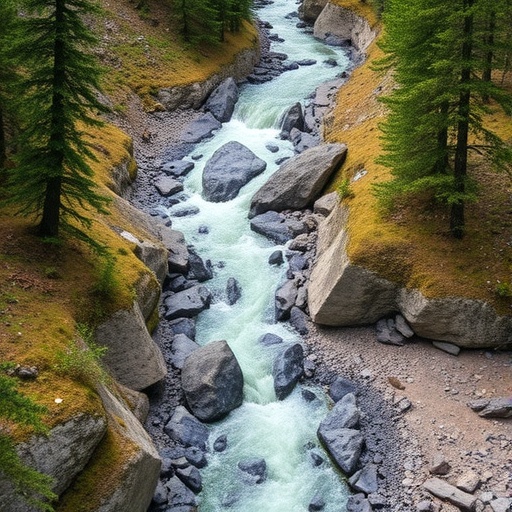In the ever-evolving study of climate change and its multifaceted impacts on global ecosystems, the research spotlight has shifted to paraglacial regions—zones heavily influenced by glacial activity that profoundly reshape both physical landscapes and ecological dynamics. A groundbreaking study led by researchers Polvi and Lind has unveiled the intricate disruptions occurring in geomorphic and biotic stream connectivity within these regions, heralding important implications for biodiversity, water quality, and ecosystem services.
Climate change is causing glaciers to retreat at unprecedented rates, altering the flow dynamics of rivers and streams. In paraglacial regions, where glaciers have recently receded, the previously established geomorphic structures are being transformed, leading to significant changes in the connectivity between water bodies. This disruption can have cascading effects on the ecological networks reliant on these streams. The research highlights that as these landscapes evolve, understanding the intricate relationships between hydrology and biology becomes essential for predicting future ecosystem functioning.
Hydrological connectivity refers to the movement of water and the organisms dependent on it within these ecosystems. The study emphasizes that disruption in this connectivity can lead to isolation of fish populations, fragmentation of aquatic habitats, and the degradation of water quality. Freshwater ecosystems, already under pressure from anthropogenic activities, face an uphill battle as climate-induced changes impose further strains on their viability.
In the present-day context, data indicate that the consequences of altered stream flows extend beyond the habitats themselves. As connectivity diminishes, so does the ability of species to migrate, reproduce, and thrive. Such fragmentation poses a severe threat to aquatic biodiversity, as fish and other aquatic organisms find themselves trapped in diminishing pools rather than being able to traverse expansive habitats. This fragmentation can contribute to inbreeding and decreased genetic diversity, making populations more vulnerable to environmental changes.
Moreover, the research underscores that stream connectivity is fundamental not only for organisms that inhabit water but also for those reliant on riparian zones. These areas are crucial for nutrient cycling, supporting various terrestrial species, and providing essential services such as water purification and flood regulation. The intertwined relationships facilitate ecosystem resilience, which becomes compromised as migration pathways are disrupted.
The study conducted by Polvi and Lind extensively evaluated different paraglacial regions, conducting field surveys and utilizing advanced modeling techniques to characterize the interplay between geomorphic changes and aquatic life. Their findings revealed alarming patterns of habitat fragmentation and loss of ecological interactions. They documented a substantial decline in the abundance and diversity of aquatic species in areas where connectivity has been significantly hampered.
Further investigation revealed that changes in sediment transport and deposition are also central to understanding these dynamics. Glacial meltwater typically alters sediment loads in streams, influencing channel morphology and, consequently, the habitats available for aquatic organisms. This complex interaction suggests that addressing sediment processes is as vital as understanding hydrological changes, as they are inherently linked to the overall health of paraglacial ecosystems.
Another layer to this intricate matrix is the role of temperature in aquatic habitats. With increasing temperatures resulting from greenhouse gas emissions, the thermal regime of streams undergoes changes that can exceed the physiological tolerances of some aquatic species. Consequently, altered temperature patterns can exacerbate existing connectivity issues, forcing species to adapt or risk local extinction.
Polvi and Lind’s work highlights the urgency of integrating geomorphic understanding with ecological management to develop effective conservation strategies. The interconnection between the physical landscape and biological communities suggests that restoration efforts must consider both dimensions. This entails not only maintaining water quality but also ensuring that natural processes that regulate stream connectivity are intact.
Policy implications stemming from this research are profound. As climate and land-use changes continue to challenge aquatic ecosystems, there is a pressing need for adaptive management approaches that prioritize resilience. Stakeholders must recognize that protecting and restoring connectivity will be pivotal in mitigating the impacts of climate change on paraglacial ecosystems.
Furthermore, as communities and policymakers grapple with the realities of climate change, the findings of this study serve as a clarion call to act. The empowerment of local communities through education on the importance of connectivity and biodiversity conservation can foster proactive measures to safeguard these critical ecosystems. Future research efforts should focus on broadening the understanding of how these systems respond dynamically to ongoing environmental changes.
The urgency of climate action cannot be overstated, as research like this underscores the intricate web of life and the delicate balance maintained through connectivity. As scientists like Polvi and Lind continue to unveil the complexities of paraglacial ecosystems, it becomes increasingly clear that our stewardship of these environments will define the legacy of our generation in the face of climate adversity.
The research by Polvi and Lind offers critical insights that extend beyond scientific discourse. It beckons a collective responsibility to address the fundamental challenges posed by climate change, advocating for a comprehensive understanding of how geomorphic changes influence our aquatic biota’s future. In this pivotal moment, we are reminded of our connection to nature and the imperative of safeguarding our planet’s invaluable resources.
Subject of Research: Disrupted geomorphic and biotic stream connectivity in paraglacial regions
Article Title: Disrupted geomorphic and biotic stream connectivity in paraglacial regions
Article References:
Polvi, L.E., Lind, L. Disrupted geomorphic and biotic stream connectivity in paraglacial regions.
Commun Earth Environ 6, 783 (2025). https://doi.org/10.1038/s43247-025-02812-1
Image Credits: AI Generated
DOI: 10.1038/s43247-025-02812-1
Keywords: paraglacial regions, stream connectivity, climate change, ecological dynamics, biodiversity, hydrological connectivity, aquatic ecosystems




